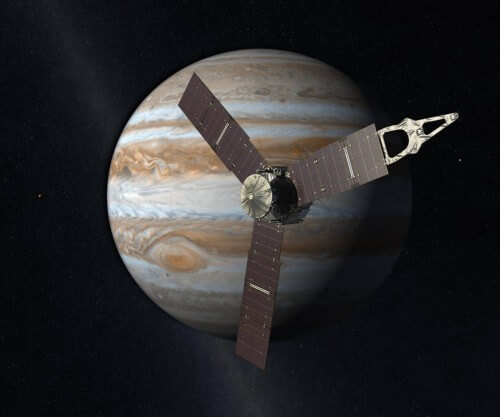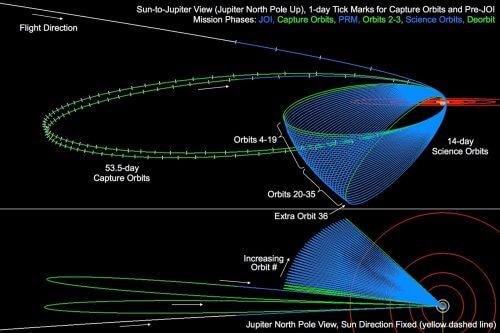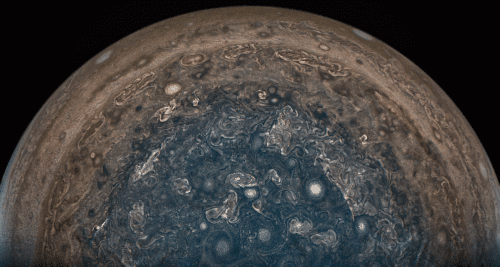Due to fear of a malfunction in Juno's rocket propulsion system, NASA decided not to perform a rocket burn that was supposed to put the spacecraft into a 14-day operational orbit around the planet Jupiter. It will remain in the initial orbit it entered when it arrived at Jupiter last July - an elongated elliptical orbit that brings it close to the planet every 53 days. The American space agency made it clear that the long orbit will not harm the probe's ability to complete the research objectives of the mission.

After deliberation that lasted several months, the US space agency Has announced The other day for its decision to avoid a planned rocket burn, which would have shortened Juno's long 53.5-day orbit to a shorter 14-day elliptical orbit.
"Juno is healthy, its science instruments are fully operational, and the information and images we've received are nothing short of amazing," said Thomas Zorbachen, NASA's associate administrator for the agency's Science Mission Directorate. "The decision to forgo burning is the right thing to do - preserving an essential asset so that Juno can continue its fascinating journey of discovery."
Juno, which was launched in 2011 and arrived at Jupiter on July 4, 2016, then entered an orbit that was supposed to be only temporary. In this orbit, in which one revolution lasts 53 days, Juno spends most of its time away from Jupiter, arriving at its farthest point (apoepside) at an enormous distance of 8.1 million kilometers from the planet. The orbit is very elliptical, and at its closest point to Jupiter (periapside) it reaches a distance of only about 4,100 km from Jupiter's upper cloud layer.
Juno was supposed to fire its rocket engine after two 53-day orbits, to shorten the orbit to a 14-day operational orbit. It is interesting to note that this flight profile is different from the mission profile as originally approved, which included an even longer initial route of 107 days (with an operational route of 11 days). Before arriving at Jupiter, NASA decided to split the initial orbit in two, out of a desire to test the spacecraft's scientific instruments before the start of its scientific phase.

The rocket burn, which was planned to take place last October, was postponed after a problem was discovered in the spacecraft's propulsion system. According to Rick Neibakan, director of the Juno project at NASA's Jet Propulsion Laboratory (JPL), the problem that was discovered was not in the engine itself, but in the helium valves that take part in the engine's fuel pressure regulation system. The valves opened too slowly than planned in the tests conducted prior to the planned rocket burn, and the engineers' fear was that they would also open too slowly during the burn itself.
"During extensive testing, we looked at a number of scenarios that would have put Juno into a shorter orbit, but there was concern that another rocket burn of the main engine would cause an undesirable orbit," Neibakan said. "The bottom line is that the burnout posed a risk to the completion of Juno's science objectives."
The agency clarified that the length of the longer orbit has no effect on the scientific data the probe will be able to collect, because both elliptical orbits have the same periapseide point (the closest point in the orbit to Jupiter) of about 4,100 km from Jupiter.
In the planned 14-day orbit, Juno was supposed to complete 37 orbits around Jupiter by the end of the mission in February 2018, when it was supposed to crash into Jupiter. Its intentional destruction is planned to prevent it from accidentally crashing into Jupiter's moon Europa, whose global ocean hidden beneath its outer ice layer may be suitable for life, and NASA is obligated to avoid "contaminating" such areas in the solar system with bacteria from Earth (this is how the probe was destroyed in 2003 Galileo who studied Jupiter).

The meaning of NASA's decision is that the mission will require a longer period to complete a number of orbits close to the original plan. But NASA has not announced an extension of the mission, and it is currently budgeted only until July 2018. Juno will complete only 12 orbits by then, and it is not entirely clear what will happen after that. Like many other NASA missions, there is a high chance that it will be approved for a "continuation mission", which also means a budgetary addition to the mission, the total cost of which is about 1.1 billion dollars.
Despite the disappointing announcement, NASA tried to emphasize the "glass half full". She noted that the current orbit is safer, as the spacecraft will spend less time in Jupiter's dangerous radiation environment. In addition to this, the long orbit also has a positive scientific aspect - the extended orbit will allow Juno to explore the remote areas of Jupiter's magnetosphere, a region of space that stretches for millions of kilometers and is affected by the planet's magnetic field.
The nature of Juno's orbit Mainly affected From the spacecraft's scientific goal to mapping the gravitational field and the magnetic field of Jupiter. To do this, she needs to get as close to it as possible, and the elliptical orbit that brings her very close to the planet was just right for that. The elliptical orbit also allows Juno to be most of the time away from Jupiter and its dangerous radiation belts that damage the spacecraft's electronic components. Due to the nature of elliptical orbits, when Juno approaches Jupiter it increases its speed, and thus it is in the dangerous radiation environment for a shorter time, but enough time to "taste" Jupiter and explore it in its entirety.
See more on the subject on the science website:
- Juno successfully completed its fourth flyby of Jupiter, February 11, 2017
- Difficulties in orbit: the Juno probe entered a safe mode and missed the photos of the close pass to Jupiter, October 21, 2016
- The Juno spacecraft arriving at Jupiter this morning will investigate, among other things, whether the giant planet has a core, July 5, 2016
- A new record for NASA: how to produce solar energy at a distance of 800 million km from the sun?, January 15, 2016
